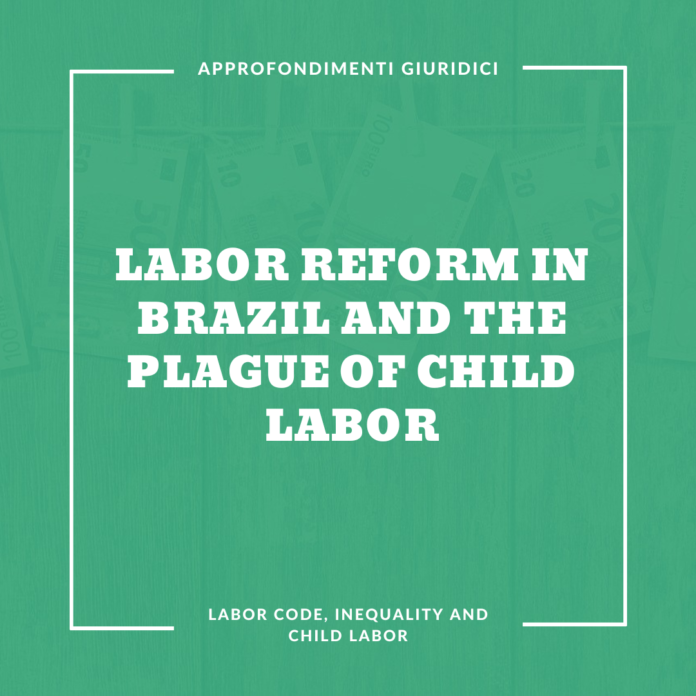
The Federative Republic of Brazil, which extends from the Amazon basin to the Iguaçu Falls, is the largest country in South America by extension and population. Brazil is made up of 26 states and a Federal District, which hosts the capital Brasilia. Although the ethnic composition of Brazil is very varied, at the linguistic level the only official language is Portuguese, which in South America is spoken only here.
Brazil has the largest economy in Latin America ranging from large deposits of natural resources to a thriving tertiary sector focused on tourism. In fact, it is thanks to its strategic position and economic potential that in recent years it has been taken into consideration by companies for their business expansion.
Brazil – which recovered between 2017 and 2019 from the severe recession of 2015-16, due to falling oil prices, low productivity and a lack of investment – has nevertheless returned to recession following the COvid-19 pandemic.
Analyzing now the working conditions of this country, the first thing that appears is the highly uneven distribution of income, the existence of large sections of the population that still live in a state of absolute poverty, and the fact that a huge quantity of manpower comes from the hands of children.
Brazilian labor law and its basic principles
In Brazil, labor law protects employees. Some basic principles implicitly or expressly provided by the Law will govern any employment relationship in Brazil, and the most relevant principles are: (a) prevalence of facts: in determining the consequences on work, the relevant facts surrounding an employment relationship will prevail over formal documents; (b) prohibition of harmful changes: employers are prevented from making changes to the terms and conditions of work that are harmful to employees, regardless of whether the employee has previously consented to the change; and (c) joint and several liability (group of companies): companies belonging to a group of legal persons under the same control, direction or direction are jointly and severally liable for the obligations of any company belonging to that group in relation to employment relationships.
In this country, it is crucial to recognize that employment relationships are a matter of federal law, so states and municipalities do not have the power to legislate on labor matters. Therefore, labor rights are nationally standardized and the same labor costs and consequences will apply regardless of the employer’s place of business or incorporation.
The code and the need of a new reform
The basic principles regarding labor relations in Brazil are contained in the Labor Code, the so-called “Consolidação das Leis do Trabalho – CLT“, issued on the 1st May 1943, but since understanding labor relations continued to be a significant challenge for Brazilians and foreigners, on the 11th November 2017, the reform was implemented, the most important changes of which include:
(1) Freedom of contract, in order to guarantee greater autonomy for the parties to negotiate: the termination of the employment contract, the means to resolve individual conflicts, the type or method of agreement.
(2) Shifts and rest,
(3) Salaries and benefits,
(4) Outsourcing,
(5) Collective bargaining on topics such as: shifts, rest and lunch breaks, compensation, employee representation, job position and salary plans.
(6) Labor liability for ex- partners, which remains limited to complaints lodged within a period of two years from the registration of the amended statute.
(7) Compensation for non-pecuniary damage.
The labor reform has really significantly changed employment relationships in Brazil, has given employers and employees more flexibility to negotiate working conditions, and has also strengthened the validity of collective bargaining with trade unions.
Furthermore, it also created two new forms of employment. The first is “intermittent work”, where the worker is paid for the work actually done on an hourly basis, since in this system periods of work alternate with periods of inactivity.
The second consists of “teleworking”, defined by article 75 of the CLT[1] as ” the provision of services mainly outside the employer’s premises, with the use of information and communication technologies which, by its nature , do not constitute external work “.
To conclude, it is possible to note that the Labor reform, consolidated in Laws 13429 and 13467/2017, has modified more than 100 articles of the Consolidated Labor Law (CLT) in an attempt to update the complex and often incomprehensible legislative, administrative and judicial structure , give more autonomy to the trade unions and to some categories of employees (considered “hypersufficient”).
The retroscene plague of child labor
Therefore, provided that the reform does not deprive workers of their rights and seeks to modernize labor laws, it is an undeniable progress and will undoubtedly help bring greater competitive advantages for companies established in Brazil.
However, MPT prosecutor Elisiane Santos in one of her speeches said that, with the reform of labor and unlimited outsourcing, there is a tendency to feed more the obscure phenomenon of child labor due to the withdrawal of rights and the fragility of work constraints. To combat this phenomenon, the organization believes that gender equality, access to education and public policies on income transfer would be needed. The “Bolsa Família” program (PBF)[2], a government programme introduced by the then-president, Lula da Silva in 2003, was created to improve this situation, and under this initiative, low-income families receive cash transfers on the condition that they, for example, send their children to school and ensure they are properly vaccinated. This model had impressive positive results, reducing levels of inequality and hunger – with significantly fewer people living below the poverty line – and closing the historical rural-urban gap. Consequently of assistance for school attendance, has been indicated as one of the ways to combat child labor because the more the household is self-sufficient, the less it depends on the presence of children and adolescents at work.
Children in Brazil work in rural and urban areas, mainly in the informal sector. In rural areas, especially in the north-eastern region, children work in the agricultural sector, and most of them are Afro descendants. Children have also been found working on cotton, cassava, pineapple, rice, sisal and tobacco farms, as well as being involved in livestock farming and the production of coal, ceramics, bricks and footwear.
In urban areas instead, common activities for working children include shoe shining, street street vending, begging, and work in restaurants, construction and transportation. Girls between the ages of 10 and 14 do housework in third-party homes for more than 40 hours per week, for which they are paid half the minimum wage or receive no payment.
There are reports of forced child labor in coal production and livestock farming. In September 2008, the special mobile unit against forced labor of the Ministry of Labor and Employment (MTE) freed 150 workers, including 30 children, who worked in forced labor conditions on a cocoa plantation in the state of Pará.
Children are involved in commercial sexual exploitation, pornography and drug trafficking. In the Amazon region, children are victims of commercial sexual exploitation in the brothels of the mining settlements. Trafficking in children is a problem. Girls are trafficked nationally and internationally for commercial sexual exploitation. The boys are trafficked internally as slaves. Child sex tourism is a problem, often involving a circle of travel agents, hotel workers, taxi drivers and traffickers. Children are sexually exploited by foreign pedophiles, mainly from Europe and North America.
In 2017, Brazil made significant progress in efforts to eliminate the worst forms of child labor. The government has released an updated version of the “Dirty List” , which contains information on employers that the Labor Department has discovered using slave labor, including that of children. Civil police officers from 24 states and the Federal District conducted a large operation to combat the sexual exploitation of children, including child pornography.
In addition, the #StopChildLabor campaign was launched to raise awareness of the world on child labor in the country.
The inefficient economic system and international conventions
However, once again, the inability to solve this problem has its roots in the economic system. Labor inspections were in fact limited to state or city capitals that have a regional Ministry of Labor office due to lack of funds for vehicles, gasoline, air travel, and daily room and board for labor inspectors. Furthermore, there are not enough labor inspectors to provide sufficient coverage of the workforce, and resources, including specialized shelters, are lacking for children who are victims of commercial sexual exploitation.
Child labor after the labor reform, and the prospects of children and adolescents, were the topics of the interview held by the Brazilian order of attorneys, through the Commission for Children, Adolescents and Youth.
Here, the labor lawyer, Ricardo José das Mercês Carneiro, addressed the changes brought about by the Reformation, analyzing that the more fragile the employment relationship, the greater the incidence of children and adolescents in prohibited or irregular work.
“The reform went against the fight against child labor. In fact, it brings a climate of precariousness in working relationships and allows to reduce family income and this ends up making the ghosts of child labor and the precarious work of adolescents return to our daily life ”.
Although, Brazil has also ratified all major international conventions on child labor such as:
- ILO C. 138, Minimum age
- ILO C. 182, The worst forms of child labor
- A CRC
- UN CRC Optional Protocol on Armed Conflict
- UN CRC Optional Protocol on the sale of children, child prostitution and child pornography
- Palermo Protocol on Trafficking in Persons
In addition, the government has also established laws and regulations relating to child labor, such as setting the minimum age to work at 16 (Article 403 of the Labor code), compulsory education up to 17 (Article 4 National educational law), and has established specific institutional mechanisms for the application of laws and regulations on child labor. Some of them are for example the Ministry of Labor (MTE) with the task of inspecting, and enforcing the law on child labor; the Labor Prosecutor’s Office (MPT) prosecuting child labor and violations in collaboration with prosecutors from the MPT National Committee; the military, civil and federal plitia, the ministry of justice and so on. The MTE in particular conducts workplace inspections in the workplace for child labor violations and collects information from inspections to develop plans to combat child labor through the Inspection Divisions on Child Labor and Child Labor and Teen Protection. Most inspections result from complaints to labor inspectors from workers, NGOs, teachers, media and other sources. Although MTE conducts labor inspections in the informal sector, they are difficult to undertake because most children work on farms and in private homes. From January 2008 to February 2009, MTE found 6,054 children working during inspections. MTE works closely with the Federal Labor Attorney’s Office (MPT), which investigates, prosecutes and brings civil charges of child labor violations, including commercial sexual exploitation of children and domestic work. It also carries out awareness campaigns, organizes public hearings to discuss child labor cases and holds local governments accountable when they have not signed the National Program for the Elimination of Child Labor or include child labor in social programs. MPT coordinates its efforts to combat child labor and protect adolescent workers through a national committee of 50 prosecutors. In addition, MTE has a special mobile unit made up of labor inspectors, federal police and prosecutors who investigate forced labor cases. Government authorities involved in the fight against trafficking include the Ministry of Social Development and Combating Hunger (MDS), the Special Secretariat for Human Rights, MTE, the Ministry of Justice (MOJ), the Ministry of External Relations (MER) and the Ministry of Tourism (MOT). The Federal Police provides training to police officers on human trafficking, with a focus on internal trafficking, and conducts operations to combat trafficking. In 2008, he arrested 59 people for international trafficking. In addition, the Federal Traffic Police provides training to traffic police officers on internal trafficking in human beings, conducts anti-trafficking operations and raises awareness of human trafficking, in particular on trafficking in children for the purpose of sexual exploitation.
To conclude with my personal opinion, I believe that the Government cannot expect to end child labor if the incentives given are not interesting. I believe that incentivizing study through money is a wrong way to bring children to class, they cannot go to school on an empty stomach or without school supplies. All the initiatives proposed by the latest governments are based on the education and specialization of the workforce, and all through financial incentives. Instead, I would believe that the solution would be to finish with the financial incentive and start with the distribution of food (similar to the ‘Basic Spending’ program which distributes a basket of the main foods of the Brazilian diet each month) for each child who goes to school. And for teenagers, I would suggest building a system of small awards based on the merit of the individual, in order to increase not only general culture, but also competitiveness for a tomorrow in the working world. Similar efforts in trying to overcome this scourge had already been made, but the current government has left child labor in the background, not giving continuity to the work previously started by the former president and trade unionist Lùla, continuing the chain of neglect of works that are truly important for the future of the country and hiding a global problem.
Bibliography
– Brazil Employer of Record https://elementsgs.com/expandopedia/brazil/
– Brazil: Overview of Recent Labor Reform By Cleber Venditti da Silva © Mattos Filho, Veiga Filho, Marrey Jr. e Quiroga Advogados, August 21, 2017 https://www.shrm.org/resourcesandtools/legal-and-compliance/employment-law/pages/brazil-labor-reform.aspx
– Brazil significant advancement, Bureau of international labor affairs, 2017 FINDINGS ON THE WORST FORMS OF CHILD LABOR.
– Employment law overview brazil 2019-2020 ,Tozzini Freire Advogados / Proud Member of L&E GLOBAL
– Especialistas criticam Reforma Trabalhista como propulsora para trabalho infantil, https://fnpeti.org.br/noticias/2018/06/25/especialistas-criticam-reforma-trabalhista-como-propulsora-para-trabalho-infantil/
– Labor Law In Brazil – Brief Overview, 07/23/20, Maria Lúcia Menezes Gadotti, Stüssi-Neves Advogados & Maria Beatriz R. Dias (beatriz.tilkian@gsga.com.br)Renata Gonçalves da SilvaGaia Silva Gaede Advogados, www.gsga.com.br , www.stussi-neves.com
– ‘Reforma’ aumenta emprego precário e alimenta trabalho infantil https://www.redebrasilatual.com.br/trabalho/2018/02/reforma-aumenta-emprego-precario-alimenta-trabalho-infantil/
– United States Department of Labor, 2008 Findings on the Worst Forms of Child Labor – Brazil, 10 September 2009, available at: https://www.refworld.org/docid/4aba3eed8.html [accessed 26 April 2021]
[1] Art. 75-A – Capítulo Ii-A. Do Teletrabalho – Clt Comparada Urgente, https://www.jusbrasil.com.br/topicos/173000266/artigo-75a-do-decreto-lei-n-5452-de-01-de-maio-de-1943
[2] https://www.centreforpublicimpact.org/case-study/bolsa-familia-in-brazil













